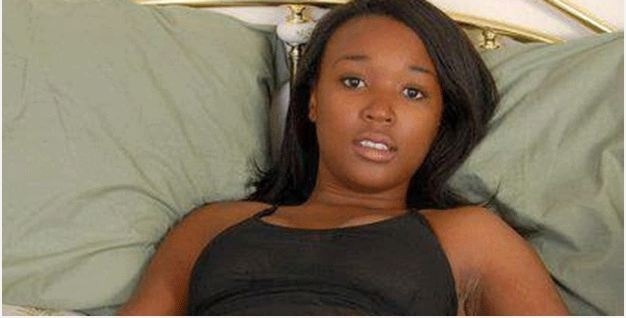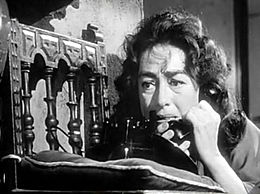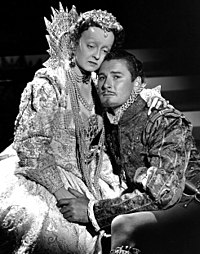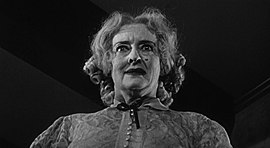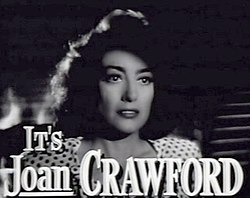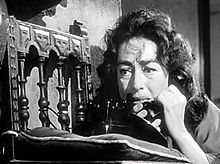Wiki
Ruth Elizabeth Davis (née le 5 avril 1908 à Lowell, Massachusetts, États-Unis et décédée le 6 octobre 1989 à Neuilly-sur-Seine, France), plus connue sous le nom de Bette Davis, est une actrice américaine de cinéma, renommée pour sa forte personnalité et son talent artistique exprimé au cours d’une carrière longue de six décennies et composée de plus d’une centaine de films.
Biographie
Fondatrice du Hollywood Canteen et l’une des actrices de cinéma les plus appréciées de l’âge d’or du cinéma, Bette Davis est connue comme un symbole de ténacité féminine, à cause de rôles de femmes impitoyables, caractérielles et hystériques, mais aussi de sa turbulente vie privée, ponctuée d’orageux mariages et de conflits médiatiques avec certaines figures du cinéma.
Alternativement appelée « reine d’Hollywood », « reine des Studios Warner » et « Première Dame du grand écran américain », Bette Davis a longtemps détenu le record du plus grand nombre de nominations aux Oscars en tant que meilleure actrice (10 fois), avant d’être détrônée par Katharine Hepburn (12 fois) puis par Meryl Streep (13 fois).
Elle a obtenu deux Oscars : en 1935 pour L’Intruse de Alfred E. Green et en 1938 pour L’Insoumise de William Wyler mais n’a jamais réussi, malgré ses fréquentes nominations, à en décrocher un troisième, ni pour ce qui est considéré comme le rôle le plus abouti et le plus talentueux de sa carrière : Ève de Joseph L. Mankiewicz, ni pour sa dernière grande interprétation marquante, dans Qu’est-il arrivé à Baby Jane ? de Robert Aldrich. De nombreux ouvrages lui ont été consacrés, dont un seul en français (Isabelle Champion, Lherminier, 1986).
Du théâtre au cinéma
Ruth Elizabeth Davis grandit dans la banlieue de Boston, élevée avec sa sœur Barbara par leur mère, Ruth, photographe, qui se séparera de son mari en 1915. On dit que les deux prénoms de Ruth Elizabeth Davis ont été remplacés par celui de Bette, en référence au roman « la Cousine Bette » de Balzac1. Après le départ de leur père, la vie des Davis oscille entre le Massachusetts, le New Jersey et New York.
Bette fait ses débuts sur les planches dans le personnage d’une fée, pour Le Songe d’une nuit d’été, pendant ses études à la Cushing Academy d’Ashburnham (Massachusetts). Elle prend ensuite des cours de danse avec Martha Graham et suit pendant trois ans les cours de la John Murray Anderson’s Acting Dramatic School à New York.
En 1928, elle fait partie d’une troupe théâtrale dirigée par George Cukor et, sous sa mise en scène, elle monte sur scène dans la pièce « Broadway » à Rochester. Suivront d’autres pièces avec Cukor avant de se produire en 1929 à New York, avec un grand succès, dans « The Earth Between » puis, elle débute enfin officiellement à Broadway dans « Broken Dishes ».
Remarquée au théâtre par un dénicheur de talents d’Universal Pictures, studio de cinéma hollywoodien, elle y tourne son premier film, The Bad Sister (1931). Carl Laemmle, directeur de la firme Universal, s’écria en voyant ce film interprété par Bette Davis : « Comment peut-on tourner un film dans lequel un homme en voit de toutes les couleurs et le terminer en cadrant sur un tel visage ? »2. Bette ne tournera plus que deux films à Universal qui ne renouvelle pas son contrat.
Après quelques rôles insignifiants dans d’autres studios (RKO, Columbia…), elle décide de rentrer à New York pour revenir au Théâtre. C’est alors qu’elle reçoit un coup de téléphone de George Arliss, grand acteur populaire de la Warner à l’époque. Il lui propose un premier rôle, auprès de lui, dans le film L’Homme qui jouait à être Dieu (1932), elle accepte. Arliss écrira dans son autobiographie « Je ne m’attendais qu’à une modeste prestation, mais ce petit rôle se transforma en une création vivante, profonde… comme une lueur illuminant un texte banal et lui communiquant émotion et passion. C’était un talent qui ne pouvait rester longtemps dans l’ombre »2. Elle épouse en 1932, Harmon O. Nelson, rencontré lors de ses études, et dont elle divorcera six ans plus tard.
La reine de la Warner
À la suite de ce film, les frères Warner, de la Warner Bros. Pictures, lui font signer un contrat de sept ans. Une période qui durera 16 ans et où l’actrice devra lutter quotidiennement pour obtenir de bons rôles dans une firme spécialisée dans les films de gangsters et qui privilégie essentiellement les personnages masculins.
Pourtant, Bette Davis n’arrête plus de tourner, on la voit dans vingt-cinq films en quatre ans, notamment avec Spencer Tracy dans Vingt mille ans sous les verrous (1933) et avec James Cagney dans Jimmy the Gent (1935), deux films de Michael Curtiz. En 1934, Bette Davis harcèle, pendant des mois, Jack Warner, un des patrons de la Warner, pour obtenir le rôle de Mildred Rogers dans L’Emprise. Il finit par céder et la « prête » à la RKO. Elle racontera : « Mes employeurs considéraient que le fait de me confier le rôle d’une héroïne aussi détestable équivaudrait à un suicide artistique… Ils m’identifaient, je suppose, au personnage, et retenaient que nous étions bien digne l’une de l’autre »3. Bette obtint un grand succès critique mais le film fut un échec commercial.
Elle fait ensuite une autre composition remarquée de garce dans Ville frontière (1935), avant d’être consacrée dans L’Intruse (1936) pour lequel elle décroche son premier Oscar de la meilleure actrice. Les frères Warner lui refusent pourtant deux rôles auxquels elle tenait : la reine Élisabeth Ire aux côtés de Katharine Hepburn dans Mary Stuart et Alice dans Alice au pays des merveilles. Mais ils lui confient un bon personnage dans La Forêt pétrifiée pour ensuite la reléguer dans deux films médiocres.
Commenceront alors les conflits avec ses producteurs. Insatisfaite de ses scénarios et après avoir refusé de tourner un film, Bette claque la porte de la Warner et quitte Hollywood pour Londres où on lui propose deux films. Un procès s’engage alors entre elle et la Warner. Elle le perd mais Jack Warner, magnanime, lui pardonne et paie les frais du procès. Olivia de Havilland aura plus de succès, elle aussi intentera un procès en 1943 contre la Warner et, le gagnera en 1945. Mais Bette Davis n’est pas complètement perdante car, malgré cette action en justice, la Warner lui confiera des scénarios de meilleure qualité.
Son retour à Hollywood se fera dans l’excellent film Femmes marquées (1937) aux côtés d’Humphrey Bogart qui lui permet de prouver à nouveau ses qualités dramatiques. Elle entame ainsi un nouveau départ à la Warner qui lui propose une série de films dont les scénarios sont écrits tout spécialement pour elle. Suivront Le Dernier combat avec Edward G. Robinson et Humphrey Bogart, Une certaine femme avec Henry Fonda, L’Aventure de minuit avec Leslie Howard et Olivia de Havilland.
Après lui avoir soumis le rôle de Scarlett O’Hara d’Autant en emporte le vent, elle le refuse, ne voulant pas se retrouver aux côtés d’Errol Flynn (condition de la Warner pour « prêter » Bette Davis à David O. Selznick) qu’elle juge trop médiocre pour le rôle de Rhett Butler.
Jack Warner lui propose alors L’Insoumise (1938), film qui ressemble étrangement à Autant en emporte le vent. Avec un personnage taillé sur mesure, la star va faire une composition des plus remarquables dans ce somptueux mélodrame dirigé de façon magistrale par le perfectionniste William Wyler. Le film connaît un énorme succès. Elle reçoit un deuxième Oscar et là commence la grande carrière de Bette Davis. Une longue série de nominations aux Oscars va également se succéder.
La suite est des plus glorieuses, vient l’ère des grands mélodrames où l’actrice va donner le meilleur d’elle-même.
Le ton est donné avec le bouleversant drame Victoire sur la nuit (1939), elle est nommée pour la troisième fois aux Oscars. Viennent ensuite deux films historiques en 1939, Juarez et La vie privée d’Elizabeth d’Angleterre, et d’autres mélos comme La Vieille Fille (1939), L’Étrangère (1940), Le Grand Mensonge (1941) qui lui donnent la place enviée de l’une des dix vedettes d’Hollywood en tête du box-office…
Le sommet de cette période est sa collaboration avec William Wyler qui sera des plus réussies. Après L’Insoumise, elle s’illustre dans les rôles de garces : dans La Lettre (1940), elle incarne une meurtrière et dans La Vipère (1941) elle interprète une femme monstrueuse, cupide et manipulatrice (elle aura une nomination aux Oscars pour chacun de ces deux films), ce qui la consacre actrice populaire et reine de la Warner. Malheureusement des conflits éclatent entre le réalisateur et l’actrice et William Wyler, malgré ces chefs-d’œuvre tournés ensemble, ne tournera plus avec Bette Davis.
Un film parachèvera cette période, modèle du genre, Une femme cherche son destin (1942) qui lui vaudra sa sixième nomination.
Elle aura encore une septième nomination pour Femme aimée est toujours jolie (1944). En 1942, elle fonde et dirige Hollywood Canteen, un organisme d’aide aux combattants de la seconde guerre mondiale et paraîtra dans le film du même nom.
Elle crée également sa propre maison de production la « B.D. Incorpored » en 1946. La Voleuse (A Stolen Life) avec Glenn Ford est le seul film produit par la firme de Bette Davis.
Après quelques films mineurs, Bette Davis tourne son dernier film à la Warner La Garce (1949) de King Vidor. Le tournage se passe mal avec le réalisateur, au point qu’elle demande un compromis à Jack Warner : elle finira le film à condition qu’il la libère de son contrat avec la Warner Bros. Lassé de ses exigences, le patron de la Warner finit par accepter.
Un renouveau
Libérée de toute contrainte, la star se remet au travail et pendant le tournage de L’Ambitieuse en 1949 (film qui sortira bien après), on lui propose un rôle magnifique : celui de Margo Channing dans Ève (1950) de Joseph L. Mankiewicz. Muni d’un scénario cynique et subtil reconstituant l’univers des théâtres et la concurrence effrénée entre les artistes, le film est un chef-d’œuvre porté par des dialogues caustiques et savoureux, la justesse de ses notations psychologiques, la remarquable interprétation de tous ses acteurs (d’ailleurs 5 sur 14 des nominations aux Oscars pour le film iront à ses interprètes) puis l’élégante mise en scène d’un cinéaste en état de grâce, véritable cheville ouvrière du projet. Ève est sans doute le plus parfait des films de Bette Davis qui y donne une prestation inoubliable unanimement saluée par la critique et couronnée par une pluie de récompenses dont le Prix d’interprétation féminine à Cannes. Après son immense succès en salles, Ève reçoit quatorze nominations aux Oscars en 1950. Il remporte 6 statuettes dont celles du meilleur film, du meilleur réalisateur et du meilleur scénario. Pour sa huitième nomination, Bette Davis se retrouve en compétition avec sa partenaire à l’écran : Anne Baxter. Mais toutes deux seront battues par Judy Holliday pour son interprétation dans Born yesterday.
Malgré un tel sommet, la carrière de Bette s’effrite au fil des ans et hormis La Star pour qui elle aura sa neuvième nomination, il lui faudra attendre les années soixante pour connaître un renouveau.
Entre-temps elle a épousé Arthur Farnsworth en 1940 (il meurt en 1943) et William Grant Sherry en 1945 (naissance de son premier enfant Barbara en 1947, et divorce en 1949), elle se remarie en 1950, une quatrième et dernière fois, avec son partenaire d’Eve, Gary Merrill, avec qui elle adoptera deux enfants Margot (1952) et Michael (1953). Elle divorcera en 1960.
En 1961, deux films viendront redorer son blason. Frank Capra, tout d’abord, lui offre Milliardaire pour un jour où elle est drôle, émouvante, grandiose en vieille clocharde au temps de la prohibition et surtout Qu’est-il arrivé à Baby Jane ? de Robert Aldrich où elle compose, aux côtés d’un autre monstre sacré de la grande époque Joan Crawford, un personnage grand-guignolesque qui lui vaudra un immense succès dans le monde entier. Elle est nommée une dixième et dernière fois aux Oscars.
« Mère de trois enfants âgés de 10, 11 et 15 ans, divorcée, de nationalité américaine, 30 ans d’expérience dans le domaine cinématographique, encore alerte et plus aimable que ne le prétend la rumeur publique, cherche emploi stable à Hollywood. Connaît Broadway. Bette Davis. Références à l’appui. » C’est cette annonce que l’actrice fait paraître, par manque de travail, dans un hebdomadaire en septembre 1962. À la suite de ce message, Jack Warner la contacte pour tourner La mort frappe trois fois (1964) avec son ami Paul Henreid, qui fut un de ses partenaires à l’écran, comme réalisateur. Elle fera un deuxième film avec Aldrich Chut… chut, chère Charlotte (1964) dans la même veine du précédent mais sans Joan Crawford qui déclare forfait et sera remplacée sur les conseils de Bette Davis, par son amie et complice de toujours, Olivia de Havilland. Elle sera encore admirable dans L’Argent de la vieille (1972) de Luigi Comencini et dans Les Baleines du mois d’août (1987) aux côtés d’une gloire du muet, Lillian Gish.
La fin de sa carrière sera moins brillante. Elle tourne dans beaucoup de films mineurs mais fait de nombreuses incursions au théâtre et à la télévision. Bette Davis décède le 6 octobre 1989 à l’hôpital américain de Neuilly-sur-Seine, à l’âge de 81 ans ; elle repose au cimetière du Forest Lawn Memorial Park des collines d’Hollywood à Los Angeles en Californie.
Citations
- Selon Gena Rowlands qui est passionnée par Bette Davis : « Elle était dure, elle adorait les conflits, ils lui donnaient son énergie. »
- Bette Davis à propos de William Wyler : « Mon histoire favorite sur la direction d’acteurs concerne Monsieur Wyler. Il ne disait jamais rien. Ça me rendait folle. L’acteur a besoin de savoir s’il plaît à son metteur en scène. Au bout d’une semaine de tournage, je suis allée le voir et je lui ai dit : « Monsieur Wyler, j’aimerais vraiment savoir si je joue comme vous le désirez. » « Ah je vois ! » a-t-il répondu. Et le lendemain, après chaque prise, il applaudissait frénétiquement en criant : « c’est merveilleux, c’est merveilleux ! » Je lui ai demandé ensuite de revenir à sa « première manière », car celle-là ne me convenait pas du tout ! (rires) Il ne donnait aucune indication de jeu. »1
Hommages
Anecdotes
- Son rôle préférée fut celui de Judith Traherne, dans Victoire sur la nuit.
- Elle fut la rivale de Miriam Hopkins qui lui en voulut pour avoir repris le rôle de Julie Marsden au cinéma alors qu’elle l’interprétait au théâtre. Elles ont néanmoins jouées toutes deux dans deux films.
- Elle pensait obtenir un Oscar pour le rôle de Baby Jane mais fut battue par Anne Bancroft. Elle insinua d’ailleurs que ce fut de la faute de Joan Crawford si elle n’avait pas gagné la statuette car cette-dernière, jalouse, aurait suppliée les organisateurs de l’Academy of Motion Picture Arts and Sciences de ne pas lui attribuer le prix.
- Elle essaya de gagner un troisième oscar mais n’y parvint pas.
Filmographie
Actrice
Cinéma
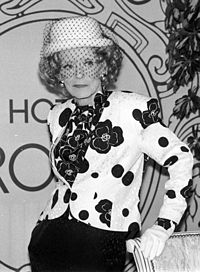
Bette Davis (1987)
Télévision
En tant que productrice
« B.D. Incorporated »
Distinctions
Doublage français
et aussi :
Ruth Elizabeth “Bette” Davis (April 5, 1908 – October 6, 1989) was an American actress of film, television and theater. Regarded as one of the greatest actresses in cinema history, she was noted for her willingness to play unsympathetic, sardonic characters and was reputed for her performances in a range of film genres, from contemporary crime melodramas to historical and period films and occasional comedies, although her greatest successes were her roles in romantic dramas.[1]
After appearing in Broadway plays, Davis moved to Hollywood in 1930, but her early films for Universal Studios (and as loanout to other studios) were unsuccessful. She joined Warner Bros. in 1932 and established her career with several critically acclaimed performances. In 1937, she attempted to free herself from her contract and although she lost a well-publicized legal case, it marked the beginning of the most successful period of her career. Until the late 1940s, she was one of American cinema’s most celebrated leading ladies, known for her forceful and intense style. Davis gained a reputation as a perfectionist who could be highly combative, and confrontations with studio executives, film directors and costars were often reported. Her forthright manner, clipped vocal style and ubiquitous cigarette contributed to a public persona which has often been imitated and satirized.
Davis was the co-founder of the Hollywood Canteen, and was the first female president of the Academy of Motion Picture Arts and Sciences. She won the Academy Award for Best Actress twice, was the first person to accrue 10 Academy Award nominations for acting, and was the first woman to receive a Lifetime Achievement Award from the American Film Institute. Her career went through several periods of eclipse, and she admitted that her success had often been at the expense of her personal relationships. Married four times, she was once widowed and thrice divorced, and raised her children as a single parent. Her final years were marred by a long period of ill health, but she continued acting until shortly before her death from breast cancer, with more than 100 films, television and theater roles to her credit. In 1999, Davis was placed second on the American Film Institute’s list of the greatest female stars of all time.
Life and career
Background and early acting career (1908–1929)
Ruth Elizabeth Davis, known from early childhood as “Betty,” was born in Lowell, Massachusetts, at 55 Cedar Street,[2] the daughter of Ruth Augusta “Ruthie” (née Favor), born in Tyngsboro, Massachusetts,[2] and Harlow Morrell Davis, a law student born in Augusta, Maine.[2] Her sister, Barbara Harriet “Bobby”, was born October 25, 1909 at 55 Ward Street in Somerville, Massachusetts, their father is now a patent attorney/lawyer.[3] The family was Protestant, of English, French, and Welsh ancestry. In 1915, Davis’s parents separated and Betty and Bobby attended a Spartan boarding school called Crestalban in Lanesborough, which is located in the Berkshires.[4] In 1921, Ruth Davis moved to New York City with her daughters, where she worked as a portrait photographer. Betty was inspired to become an actress after seeing Rudolph Valentino in The Four Horsemen of the Apocalypse (1921) and Mary Pickford in Little Lord Fauntleroy (1921),[5] and changed the spelling of her name to “Bette” after Honoré de Balzac‘s La Cousine Bette.[6] She received encouragement from her mother, who had aspired to become an actress.
She attended Cushing Academy, a boarding school in Ashburnham, Massachusetts, where she met her future husband, Harmon O. Nelson, known as “Ham.” In 1926, she saw a production of Henrik Ibsen‘s The Wild Duck with Blanche Yurka and Peg Entwistle. Davis later recalled that it inspired her full commitment to her chosen career, and said, “Before that Entwistle.”[7] She auditioned for admission to Eva LeGallienne‘s Manhattan Civic Repertory, but was rejected by LeGallienne who described her attitude as “insincere” and “frivolous.”[8] She was accepted by the John Murray Anderson School of Theatre, and studied dance with Martha Graham.
She auditioned for George Cukor‘s stock theater company, and although he was not very impressed, he gave Davis her first paid acting assignment anyway—a one-week stint playing the part of a chorus girl in the play Broadway. She was later chosen to play Hedwig, the character she had seen Entwistle play, in The Wild Duck. After performing in Philadelphia, Washington and Boston, she made her Broadway debut in 1929 in Broken Dishes, and followed it with Solid South. A Universal Studios talent scout saw her perform and invited her to Hollywood for a screen test.
Early years in Hollywood (1930–1936)
Accompanied by her mother, Davis traveled by train to Hollywood, arriving on December 13, 1930. She later recounted her surprise that nobody from the studio was there to meet her; a studio employee had waited for her, but left because he saw nobody who “looked like an actress.” She failed her first screen test but was used in several screen tests for other actors. In a 1971 interview with Dick Cavett, she related the experience with the observation, “I was the most Yankee-est, most modest virgin who ever walked the earth. They laid me on a couch, and I tested fifteen men … They all had to lie on top of me and give me a passionate kiss. Oh, I thought I would die. Just thought I would die.”[9] A second test was arranged for Davis, for the film A House Divided (1931). Hastily dressed in an ill-fitting costume with a low neckline, she was rebuffed by the director William Wyler, who loudly commented to the assembled crew, “What do you think of these dames who show their chests and think they can get jobs?”[10]
Carl Laemmle, the head of Universal Studios, considered terminating Davis’s employment, but cinematographer Karl Freund told him she had “lovely eyes” and would be suitable for The Bad Sister (1931), in which she subsequently made her film debut.[11] Her nervousness was compounded when she overheard the Chief of Production, Carl Laemmle, Jr., comment to another executive that she had “about as much sex appeal as Slim Summerville,” one of the film’s co-stars.[12] The film was not a success, and her next role in Seed (1931) was too brief to attract attention.
Universal Studios renewed her contract for three months, and she appeared in a small role in Waterloo Bridge (1931) before being lent to Columbia Pictures for The Menace and to Capital Films for Hell’s House (all 1932). After nine months, and six unsuccessful films, Laemmle elected not to renew her contract.
Davis was preparing to return to New York when actor George Arliss chose Davis for the lead female role in the Warner Brothers picture The Man Who Played God (1932), and for the rest of her life, Davis credited him with helping her achieve her “break” in Hollywood. The Saturday Evening Post wrote, “she is not only beautiful, but she bubbles with charm,” and compared her to Constance Bennett and Olive Borden.[13] Warner Bros. signed her to a five-year contract, and she remained with the studio for the next eighteen years, garnering great acclaim for herself as well as making a fortune for her employers.
In 1932, she married Harmon “Ham” Nelson, who was scrutinized by the press; his $100 a week earnings compared unfavorably with Davis’s reported $1,000 a week income. Davis addressed the issue in an interview, pointing out that many Hollywood wives earned more than their husbands, but the situation proved difficult for Nelson, who refused to allow Davis to purchase a house until he could afford to pay for it himself.[14] Davis had several abortions during the marriage.[15]
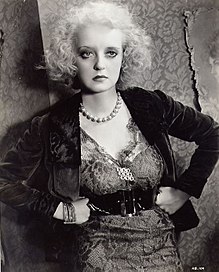
As the shrewish Mildred in
Of Human Bondage (1934), Davis was acclaimed for her dramatic performance
After more than 20 film roles, the role of the vicious and slatternly Mildred Rogers in the RKO Radio production of Of Human Bondage (1934), a film adaptation of W. Somerset Maugham‘s novel, earned Davis her first major critical acclaim. Many actresses feared playing unsympathetic characters and several had refused the role, but Davis viewed it as an opportunity to show the range of her acting skills. Her co-star, Leslie Howard, was initially dismissive of her, but as filming progressed his attitude changed and he subsequently spoke highly of her abilities. The director, John Cromwell, allowed her relative freedom, and commented, “I let Bette have her head. I trusted her instincts.” She insisted that she be portrayed realistically in her death scene, and said, “the last stages of consumption, poverty and neglect are not pretty and I intended to be convincing-looking.”[16]
The film was a success, and Davis’s confronting characterization won praise from critics, with Life magazine writing that she gave “probably the best performance ever recorded on the screen by a U.S. actress.”[17] Davis anticipated that her reception would encourage Warner Bros. to cast her in more important roles, and was disappointed when Jack Warner refused to lend her to Columbia Studios to appear in It Happened One Night, and instead cast her in the melodrama Housewife.[18] When Davis was not nominated for an Academy Award for Of Human Bondage, The Hollywood Citizen News questioned the omission and Norma Shearer, herself a nominee, joined a campaign to have Davis nominated. This prompted an announcement from the Academy president, Howard Estabrook, who said that under the circumstances “any voter … may write on the ballot his or her personal choice for the winners,” thus allowing, for the only time in the Academy’s history, the consideration of a candidate not officially nominated for an award.[19] Claudette Colbert won the award for It Happened One Night but the uproar led to a change in Academy voting procedures the following year, whereby nominations were determined by votes from all eligible members of a particular branch, rather than by a smaller committee,[20] with results independently tabulated by the accounting firm Price Waterhouse.[21]
Davis appeared in Dangerous (1935) as a troubled actress and received very good reviews. E. Arnot Robertson wrote in Picture Post, “I think Bette Davis would probably have been burned as a witch if she had lived two or three hundred years ago. She gives the curious feeling of being charged with power which can find no ordinary outlet.” The New York Times hailed her as “becoming one of the most interesting of our screen actresses.”[22] She won the Academy Award for Best Actress for the role, but commented it was belated recognition for Of Human Bondage, calling the award a “consolation prize.”[23] For the rest of her life, Davis maintained that she gave the statue its familiar name of “Oscar” because its posterior resembled that of her husband, whose middle name was Oscar,[24][25] although her claim has been disputed by the Academy of Motion Picture Arts and Sciences, among others.
In her next film, The Petrified Forest (1936), Davis co-starred with Leslie Howard and Humphrey Bogart, but Bogart, in his first important role, received most of the critics’ praise. Davis appeared in several films over the next two years but most were poorly received.
Legal case
Convinced that her career was being damaged by a succession of mediocre films, Davis accepted an offer in 1936 to appear in two films in Britain. Knowing that she was breaching her contract with Warner Bros., she fled to Canada to avoid legal papers being served upon her. Eventually, Davis brought her case to court in Britain, hoping to get out of her contract with Warner Bros.[26] She later recalled the opening statement of the barrister, Sir Patrick Hastings, who represented Warner Bros. Hastings urged the court to “come to the conclusion that this is rather a naughty young lady and that what she wants is more money.” He mocked Davis’s description of her contract as “slavery” by stating, incorrectly, that she was being paid $1,350 per week. He remarked, “if anybody wants to put me into perpetual servitude on the basis of that remuneration, I shall prepare to consider it.” The British press offered little support to Davis, and portrayed her as overpaid and ungrateful.[27]
Davis explained her viewpoint to a journalist, saying “I knew that, if I continued to appear in any more mediocre pictures, I would have no career left worth fighting for.”[28] Davis’s counsel presented her complaints—that she could be suspended without pay for refusing a part, with the period of suspension added to her contract, that she could be called upon to play any part within her abilities regardless of her personal beliefs, that she could be required to support a political party against her beliefs, and that her image and likeness could be displayed in any manner deemed applicable by the studio. Jack Warner testified, and was asked, “Whatever part you choose to call upon her to play, if she thinks she can play it, whether it is distasteful and cheap, she has to play it?” Warner replied, “Yes, she must play it.”[29] The case, decided by Branson J. in the English High Court, was reported as Warner Bros. Studios Incorporated v. Nelson in [1937] 1 KB 209. Davis lost the case and returned to Hollywood, in debt and without income, to resume her career. Olivia de Havilland mounted a similar case in 1943 and won.
Success with Warner Bros. (1937–1941)
Davis began work on Marked Woman (1937), as a prostitute in a contemporary gangster drama inspired by the case of Lucky Luciano. For her performance in the film she was awarded the Volpi Cup at the 1937 Venice Film Festival.[30] Her next picture was Jezebel (1938), and during production Davis entered a relationship with director William Wyler. She later described him as the “love of my life,” and said that making the film with him was “the time in my life of my most perfect happiness.”[31] The film was a success, and Davis’ performance as a spoiled Southern belle earned her a second Academy Award, which led to speculation in the press that she would be chosen to play a similar character, Scarlett O’Hara, in Gone with the Wind. Davis expressed her desire to play Scarlett, and while David O. Selznick was conducting a search for the actress to play the role, a radio poll named her as the audience favorite. Warners offered her services to Selznick as part of a deal that also included Errol Flynn and Olivia de Havilland, but Selznick did not consider Davis as suitable, and rejected the offer,[32] while Davis did not want Flynn cast as Rhett Butler.
Jezebel marked the beginning of the most successful phase of Davis’ career, and over the next few years she was listed in the annual “Quigley Poll of the Top Ten Money Making Stars,” which was compiled from the votes of movie exhibitors throughout the U.S. for the stars that had generated the most revenue in their theaters over the previous year.[33] In contrast to Davis’ success, her husband, Ham Nelson, had failed to establish a career for himself, and their relationship faltered. In 1938, Nelson obtained evidence that Davis was engaged in a sexual relationship with Howard Hughes and subsequently filed for divorce citing Davis’ “cruel and inhuman manner.”[34]
She was emotional during the making of her next film, Dark Victory (1939), and considered abandoning it until the producer Hal B. Wallis convinced her to channel her despair into her acting. The film became one of the highest grossing films of the year, and the role of Judith Traherne brought her an Academy Award nomination. In later years, Davis cited this performance as her personal favorite.[35] She appeared in three other box office hits in 1939, The Old Maid with Miriam Hopkins, Juarez with Paul Muni and The Private Lives of Elizabeth and Essex with Errol Flynn. The latter was her first color film and her only color film made during the height of her career. To play the elderly Elizabeth I of England, Davis shaved her hairline and eyebrows. During filming she was visited on the set by the actor Charles Laughton. She commented that she had a “nerve” playing a woman in her sixties, to which Laughton replied, “Never not dare to hang yourself. That’s the only way you grow in your profession. You must continually attempt things that you think are beyond you, or you get into a complete rut.” Recalling the episode many years later, Davis remarked that Laughton’s advice had influenced her throughout her career.[36]
By this time, Davis was Warner Bros.’ most profitable star, and she was given the most important of their female leading roles. Her image was considered with more care; although she continued to play character roles, she was often filmed in close-ups that emphasized her distinctive eyes. All This and Heaven Too (1940) was the most financially successful film of Davis’ career to that point, while The Letter (1940) was considered “one of the best pictures of the year” by The Hollywood Reporter, and Davis won admiration for her portrayal of an adulterous killer, a role originated by famed actress Katharine Cornell.[37] During this time, she was in a relationship with her former costar George Brent, who proposed marriage. Davis refused, as she had met Arthur Farnsworth, a New England innkeeper. Davis and Farnsworth were married at Home Ranch, in Lake Montezuma, Arizona, in December 1940.

Davis often played unlikable characters, such as Regina Giddens in
The Little Foxes (1941)
In January 1941, Davis became the first female president of the Academy of Motion Picture Arts and Sciences but antagonized the committee members with her brash manner and radical proposals. Faced with the disapproval and resistance of the committee, Davis resigned, and was succeeded by her predecessor Walter Wanger. Davis starred in three movies in 1941, the first being The Great Lie, opposite George Brent. It was a refreshingly different role for Davis, as she played a kind, sympathetic character. Brent tickled Davis during many of the film’s scenes, which allowed the audience, used to Davis’ strong-willed character, a rare glimpse of her succumbing to giggles and squirms.
William Wyler directed Davis for the third time in Lillian Hellman‘s The Little Foxes (RKO, 1941), but they clashed over the character of Regina Giddens. Taking a role originally played on stage by Tallulah Bankhead, Davis felt Bankhead’s original interpretation was appropriate and followed Hellman’s intent, but Wyler wanted her to soften the character. Davis refused to compromise. She received another Academy Award nomination for her performance, and never worked with Wyler again.
War effort and personal tragedy (1942–1944)
Following the attack on Pearl Harbor, Davis spent the early months of 1942 selling war bonds. After Jack Warner criticized her tendency to cajole crowds into buying, she reminded him that her audiences responded most strongly to her “bitch” performances. She sold two million dollars worth of bonds in two days, as well as a picture of herself in Jezebel for $250,000. She also performed for black regiments as the only white member of an acting troupe formed by Hattie McDaniel, which included Lena Horne and Ethel Waters.[38]
At John Garfield‘s suggestion of opening a servicemen’s club in Hollywood, Davis—with the aid of Warner, Cary Grant and Jule Styne—transformed an old nightclub into the Hollywood Canteen, which opened on October 3, 1942. Hollywood’s most important stars volunteered to entertain servicemen. Davis ensured that every night there would be a few important “names” for the visiting soldiers to meet.[39] She appeared as herself in the film Hollywood Canteen (1944), which used the canteen as the setting for a fictional story. Davis later commented, “There are few accomplishments in my life that I am sincerely proud of. The Hollywood Canteen is one of them.” In 1980, she was awarded the Distinguished Civilian Service Medal, the United States Department of Defense‘s highest civilian award, for her work with the Hollywood Canteen.[40]
Davis showed little interest in the film Now, Voyager (1942) until Hal Wallis advised her that female audiences needed romantic dramas to distract them from the reality of their lives. It became one of the best known of her “women’s pictures.” In one of the film’s most imitated scenes, Paul Henreid lights two cigarettes as he stares into Davis’ eyes and passes one to her. Film reviewers complimented Davis on her performance, the National Board of Review commenting that she gave the film “a dignity not fully warranted by the script.”[41]
During the early 1940s, several of Davis’ film choices were influenced by the war, such as Watch on the Rhine (1943), by Lillian Hellman, and Thank Your Lucky Stars (1943), a lighthearted all-star musical cavalcade, with each of the featured stars donating their fee to the Hollywood Canteen. Davis performed a novelty song, “They’re Either Too Young or Too Old,” which became a hit record after the film’s release. Old Acquaintance (1943) reunited her with Miriam Hopkins in a story of two old friends who deal with the tensions created when one of them becomes a successful novelist. Davis felt that Hopkins tried to upstage her throughout the film. Director Vincent Sherman recalled the intense competitiveness and animosity between the two actresses, and Davis often joked that she held back nothing in a scene in which she was required to shake Hopkins in a fit of anger.[42]
In August 1943, Davis’ husband, Arthur Farnsworth, collapsed while walking along a Hollywood street and died two days later. An autopsy revealed that his fall had been caused by a skull fracture he had suffered two weeks earlier. Davis testified before an inquest that she knew of no event that might have caused the injury. A finding of accidental death was reached. Highly distraught, Davis attempted to withdraw from her next film Mr. Skeffington (1944); but Jack Warner, who had halted production following Farnsworth’s death, convinced her to continue. Although she had gained a reputation for being forthright and demanding, her behavior during filming of Mr. Skeffington was erratic and out of character. She alienated Vincent Sherman by refusing to film certain scenes and insisting that some sets be rebuilt. She improvised dialogue, causing confusion among other actors, and infuriated the writer, Julius Epstein, who was called upon to rewrite scenes at her whim. Davis later explained her actions with the observation, “when I was most unhappy I lashed out rather than whined.” Some reviewers criticized Davis for the excess of her performance; James Agee wrote that she “demonstrates the horrors of egocentricity on a marathonic scale;”[43] but despite the mixed reviews, she received another Academy Award nomination.
Professional setbacks (1945–1949)

In
The Corn Is Green (1945). Despite the studio’s suggestion that Davis play the role as a young woman, the 38-year-old insisted on aging her appearance to fit the part.
In 1945, Davis married artist William Grant Sherry, who also, when necessary, worked as a masseur. She had been drawn to him because he claimed he had never heard of her and was, therefore, not intimidated by her.[44] The same year, Davis refused the title role in Mildred Pierce (1945),[45] a role for which Joan Crawford won an Academy Award, and instead made The Corn Is Green (1945) based on a play by Emlyn Williams. Davis played Miss Moffat, an English teacher who saves a young Welsh miner (John Dall) from a life in the coal pits, by offering him education. The part had been played in the theatre by Ethel Barrymore, but Warner Bros. felt that the film version should depict the character as a younger woman. Davis disagreed and insisted on playing the part as written and wore a gray wig and padding under her clothes, to create a dowdy appearance.[46] The film was well received by critics and made a profit of $2.2 million.[47] The critic E. Arnot Robertson observed that “only Bette Davis . . . could have combated so successfully the obvious intention of the adaptors of the play to make frustrated sex the mainspring of the chief character’s interest in the young miner.” She concluded that “the subtle interpretation she insisted on giving” kept the focus on the teacher’s “sheer joy in imparting knowledge.”[48]
Her next film, A Stolen Life (1946), was the first and only film that Davis made with her own production company, BD Productions.[49] Davis played dual roles, as twins. The film received poor reviews and was described by Bosley Crowther as “a distressingly empty piece;”[50] but, with a profit of $2.5 million, it was one of her biggest box-office successes.[51] In 1947, the U.S. Treasury named Davis as the highest paid woman in the country,[52] with her share of the film’s profit accounting for most of her earnings. Her next film was Deception (1946), the first of her films to lose money.[53]
Possessed (1947) had been tailor-made for Davis[54] and was to have been her next project after Deception. However, she was pregnant and went on maternity leave. Joan Crawford played her role in Possessed and was nominated for an Academy Award as Best Actress. In 1947, at the age of 39, Davis gave birth to a daughter, Barbara Davis Sherry (known as B.D.) and later wrote in her memoir that she became absorbed in motherhood and considered ending her career. However, her relationship with Sherry began to deteriorate and she continued making films, but her popularity with audiences was steadily declining.[55]
Among the film roles offered to Davis following her return to film making was Rose Sayer in The African Queen (1951). When informed that the film was to be shot in Africa, Davis refused the part, telling Jack Warner, “If you can’t shoot the picture in a boat on the back lot, then I’m not interested.” Katharine Hepburn played the role and was nominated for an Academy Award as Best Actress.[56] Davis was also offered a role in a film version of the Virginia Kellogg prison drama Women Without Men. Originally intended to pair Davis with Joan Crawford, Davis made it clear that she would not appear in any “dyke movie.” It was filmed as Caged (1950), and the lead roles were played by Eleanor Parker (who was nominated for an Academy Award as Best Actress) and Agnes Moorehead.[57] She lobbied Jack Warner to make two films, Ethan Frome and a biography of Mary Todd Lincoln; however, Warner vetoed each proposal.

Beyond the Forest (1949) was the last film Davis made for Warner Bros., after 17 years with the studio
In 1948, Davis was cast in the melodrama Winter Meeting; and, although she was initially enthusiastic, she soon learned that Warner had arranged for “softer” lighting to be used to disguise her age. She recalled that she had seen the same lighting technique “on the sets of Ruth Chatterton and Kay Francis, and I knew what they meant.”[58] She began to regret accepting the role; and, to add to her disappointment, she was not confident in the abilities of her leading man, James Davis in his first major screen role. She disagreed with amendments made to the script because of censorship restrictions and found that many of the aspects of the role that had initially appealed to her had been cut. The film was later described by Bosley Crowther as “interminable;” and he noted that “of all the miserable dilemmas in which Miss Davis has been involved … this one is probably the worst”. It failed at the box office, and the studio lost nearly one million dollars.[59]
While making June Bride (1948), Davis clashed with co-star Robert Montgomery, later describing him as “a male Miriam Hopkins… an excellent actor, but addicted to scene-stealing.”[60] The film marked her first comedy in several years and earned her some positive reviews; but it was not particularly popular with audiences and returned only a small profit. Despite the lackluster box office receipts from her more recent films, in 1949, she negotiated a four-film contract with Warner Bros., which paid $10,285 per week and made her the highest-paid woman in the United States.[61] Jack Warner refused to allow her script approval, however, and cast her in Beyond the Forest (1949). Davis reportedly loathed the script and begged Warner to recast the role, but he refused. After the film was completed, Warner released Davis from her contract, at her request. The reviews that followed were scathing; Dorothy Manners writing for the Los Angeles Examiner described the film as “an unfortunate finale to her brilliant career.” [62] Hedda Hopper wrote, “If Bette had deliberately set out to wreck her career, she could not have picked a more appropriate vehicle.”[63] The film contained the line, “What a dump!,” which became closely associated with Davis after it was referenced in Edward Albee‘s Who’s Afraid of Virginia Woolf?, and impersonators began to use it in their acts. In later years, Davis often used it as her opening line at speaking engagements.
Starting a freelance career (1949–1960)

Davis posing as Margo Channing in a promotional image for
All About Eve (1950). She is pictured with
Gary Merrill, to whom she was married from 1950 to 1960 (her fourth and final husband)
By 1949, Davis and Sherry were estranged and Hollywood columnists were writing that Davis’ career was at an end. She filmed The Story of a Divorce (released by RKO Radio Pictures in 1951 as Payment on Demand) but had received no other offers. Shortly before filming was completed, the producer Darryl F. Zanuck offered her the role of the aging theatrical actress Margo Channing in All About Eve (1950). Claudette Colbert, for whom the part had been written, had severely injured her back, and she was unable to continue. Davis read the script, described it as the best she had ever read, and accepted the role. Within days she joined the cast in San Francisco to begin filming. During production, she established what would become a lifelong friendship with her co-star, Anne Baxter, and a romantic relationship with her leading man, Gary Merrill, which led to marriage. The film’s director Joseph L. Mankiewicz later remarked, “Bette was letter perfect. She was syllable-perfect. The director’s dream: the prepared actress.”[64]
Critics responded positively to Davis’ performance and several of her lines became well-known, particularly, “Fasten your seatbelts, it’s going to be a bumpy night.” She was again nominated for an Academy Award and critics such as Gene Ringgold described her Margo as her “all-time best performance.”[65] Pauline Kael wrote that much of Mankiewicz’ vision of “the theater” was “nonsense” but commended Davis, writing “[the film is] saved by one performance that is the real thing: Bette Davis is at her most instinctive and assured. Her actress—vain, scared, a woman who goes too far in her reactions and emotions—makes the whole thing come alive.”[66] Davis won a Best Actress award from the Cannes Film Festival, and the New York Film Critics Circle Award. She also received the San Francisco Film Critics Circle Award as “Best Actress”, having been named by them as the “Worst Actress” of 1949 for Beyond the Forest. During this time she was invited to leave her handprints in the forecourt of Grauman’s Chinese Theatre.
On July 3, 1950 Davis’ divorce from William Sherry was finalized, and on July 28 she married Gary Merrill. With Sherry’s consent, Merrill adopted B.D., Davis’ daughter with Sherry, and in 1950, Davis and Merrill adopted a baby girl they named Margot. The family traveled to England, where Davis and Merrill starred in a murder-mystery film, Another Man’s Poison (1951). When it received lukewarm reviews and failed at the box office, Hollywood columnists wrote that Davis’ comeback had petered out, and an Academy Award nomination for The Star (1952) did not halt her decline.
Davis and Merrill adopted a baby boy, Michael, in 1952, and Davis appeared in a Broadway revue, Two’s Company directed by Jules Dassin. She was uncomfortable working outside of her area of expertise; she had never been a musical performer and her limited theater experience had been more than 20 years earlier. She was also severely ill and was operated on for osteomyelitis of the jaw. Margot was diagnosed as severely brain damaged due to an injury sustained during or shortly after her birth, and was eventually placed in an institution. Davis and Merrill began arguing frequently, with B.D. later recalling episodes of alcohol abuse and domestic violence.[67]
Few of Davis’ films of the 1950s were successful and many of her performances were condemned by critics. The Hollywood Reporter wrote of mannerisms “that you’d expect to find in a nightclub impersonation of [Davis],” while the London critic, Richard Winninger, wrote, “Miss Davis, with more say than most stars as to what films she makes, seems to have lapsed into egoism. The criterion for her choice of film would appear to be that nothing must compete with the full display of each facet of the Davis art. Only bad films are good enough for her.”[68] Her films of this period included The Virgin Queen (1955), Storm Center (1956), and The Catered Affair (1956). As her career declined, her marriage continued to deteriorate until she filed for divorce in 1960. The following year, her mother died. During the same time, she tried television, appearing in three episodes of the popular NBC western Wagon Train as three different characters in 1959 and 1961; her first appearance on TV had been 25 February 1956, on General Electric Theatre.[69]
Renewed success (1961–1970)
In 1961, Davis opened in the Broadway production The Night of the Iguana to mostly mediocre reviews, and left the production after four months due to “chronic illness.” She then joined Glenn Ford and Ann-Margret for the Frank Capra film A Pocketful of Miracles (1961) (a remake of Capra’s 1933 film, Lady for a Day), based on a story by Damon Runyon. She accepted her next role, in the Grand Guignol horror film What Ever Happened to Baby Jane? (1962) after reading the script and believing it could appeal to the same audience that had recently made Alfred Hitchcock‘s Psycho (1960) a success. She negotiated a deal that would pay her 10 percent of the worldwide gross profits, in addition to her salary. The film became one of the year’s biggest successes.[70]
Davis and Joan Crawford played two aging sisters, former actresses forced by circumstance to share a decaying Hollywood mansion. The director, Robert Aldrich, explained that Davis and Crawford were each aware of how important the film was to their respective careers and commented, “It’s proper to say that they really detested each other, but they behaved absolutely perfectly.”[71] After filming was completed, their public comments against each other allowed the tension to develop into a lifelong feud. When Davis was nominated for an Academy Award, Crawford contacted the other Best Actress nominees (who were unable to attend the ceremonies) and offered to accept the award on their behalf should they win. Davis also received her only BAFTA Award nomination for this performance. Daughter Barbara (credited as B. D. Merrill) played a small role in the film and when she and Davis visited the Cannes Film Festival to promote it, she met Jeremy Hyman, an executive for Seven Arts Productions. After a short courtship, she married Hyman at the age of 16, with Davis’ permission.
In early 1963 while Raymond Burr was recovering from surgery, Davis guest starred in the first of four episodes of Perry Mason, with Burr doing only cameo roles. She portrayed a recently widowed attorney who defended Cal Leonard accused of murdering his cousin in “The Case of Constant Doyle.” In court she exposed her personal secretary, Miss Givney, played by Frances Reid, as the murderer. Davis portrayed the title character in that episode.
In September 1962, Davis placed an advertisement in Variety under the heading of “Situations wanted—women artists,” which read, “Mother of three—10, 11 & 15—divorcee. American. Thirty years experience as an actress in Motion Pictures. Mobile still and more affable than rumor would have it. Wants steady employment in Hollywood. (Has had Broadway).”[72] Davis said that she intended it as a joke, and she sustained her comeback over the course of several years. Dead Ringer (1964) was a crime drama in which she played twin sisters and Where Love Has Gone (1964) was a romantic drama based on a Harold Robbins novel. Davis played the mother of Susan Hayward but filming was hampered by heated arguments between Davis and Hayward.[73] Hush… Hush, Sweet Charlotte (1964) was Robert Aldrich’s follow-up to What Ever Happened to Baby Jane?, in which he planned to reunite Davis and Crawford, but when Crawford withdrew allegedly due to illness soon after filming began, she was replaced by Olivia de Havilland. The film was a considerable success and brought renewed attention to its veteran cast, which also included Joseph Cotten, Mary Astor and Agnes Moorehead. The following year, Davis was cast as the lead in an Aaron Spelling sitcom, The Decorator.[74] A pilot episode was filmed, but was not shown, and the project was terminated. By the end of the decade, Davis had appeared in the British films The Nanny (1965), The Anniversary (1968), and Connecting Rooms (1970), but her career again stalled.
Late career (1971–1983)
In the early 1970s, Davis was invited to appear in New York, in a stage presentation, Great Ladies of the American Cinema. Over five successive nights, a different female star discussed her career and answered questions from the audience; Myrna Loy, Rosalind Russell, Lana Turner, Sylvia Sidney, and Joan Crawford were the other participants. Davis was well received and was invited to tour Australia with the similarly themed, Bette Davis in Person and on Film, and its success allowed her to take the production to the United Kingdom.[75]
In 1972, she played the lead role in two television films that were each intended as pilots for upcoming series for NBC, Madame Sin with Robert Wagner, and The Judge and Jake Wyler, with Joan Van Ark, but in each case, NBC decided against producing a series. She appeared in the stage production, Miss Moffat, a musical adaptation of her film The Corn is Green, but after the show was panned by the Philadelphia critics during its pre-Broadway run, she cited a back injury and abandoned the show, which closed immediately. She played supporting roles in Burnt Offerings (1976) and The Disappearance of Aimee (1976), but clashed with Karen Black and Faye Dunaway, the stars of the two respective productions, because she felt that neither extended her an appropriate degree of respect, and that their behavior on the film sets was unprofessional.[76]
In 1977, Davis became the first woman to receive the American Film Institute‘s Lifetime Achievement Award. The televised event included comments from several of Davis’s colleagues including William Wyler who joked that given the chance Davis would still like to refilm a scene from The Letter to which Davis nodded. Jane Fonda, Henry Fonda, Natalie Wood and Olivia de Havilland were among the performers who paid tribute, with de Havilland commenting that Davis “got the roles I always wanted”.[77] Following the telecast she found herself in demand again, often having to choose between several offers. She accepted roles in the television miniseries The Dark Secret of Harvest Home (1978) and the theatrical film Death on the Nile (1978), an Agatha Christie murder mystery. The bulk of her remaining work was for television. She won an Emmy Award for Strangers: The Story of a Mother and Daughter (1979) with Gena Rowlands, and was nominated for her performances in White Mama (1980) and Little Gloria… Happy at Last (1982). She also played supporting roles in two Disney films, Return from Witch Mountain (1978) and The Watcher in the Woods (1980).
Davis’ name became well-known to a younger audience when Kim Carnes‘ song “Bette Davis Eyes” (written by Jackie DeShannon) became a worldwide hit and the best-selling record of 1981 in the U.S., where it stayed at number one on the music charts for more than two months. Davis’s grandson was impressed that she was the subject of a hit song and Davis considered it a compliment, writing to both Carnes and the songwriters, and accepting the gift of gold and platinum records from Carnes, and hanging them on her wall.[78][79] She continued acting for television, appearing in Family Reunion (1981) opposite her grandson J. Ashley Hyman, A Piano for Mrs. Cimino (1982) and Right of Way (1983) with James Stewart. In 1983, she was awarded the Women in Film Crystal Award.[80]
Illness, conflict and death (1983–1989)
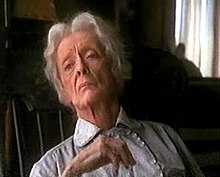
Davis’ final completed role in
The Whales of August (1987) brought her acclaim during a period in which she was beset with failing health and personal trauma.
In 1983, after filming the pilot episode for the television series Hotel, Davis was diagnosed with breast cancer and underwent a mastectomy. Within two weeks of her surgery she suffered four strokes which caused paralysis in the left side of her face and in her left arm, and left her with slurred speech. She commenced a lengthy period of physical therapy and, aided by her personal assistant, Kathryn Sermak, gained partial recovery from the paralysis.
During this time, her relationship with her daughter, B. D. Hyman, deteriorated when Hyman became a born-again Christian and attempted to persuade Davis to follow suit. With her health stable, she traveled to England to film the Agatha Christie mystery Murder with Mirrors (1985). Upon her return, she learned that Hyman had published a memoir, My Mother’s Keeper, in which she chronicled a difficult mother-daughter relationship and depicted scenes of Davis’ overbearing and drunken behavior. Several of Davis’ friends commented that Hyman’s depictions of events were not accurate; one said, “so much of the book is out of context.” Mike Wallace rebroadcast a 60 Minutes interview he had filmed with Hyman a few years earlier in which she commended Davis on her skills as a mother, and said that she had adopted many of Davis’ principles in raising her own children. Critics of Hyman noted that Davis had financially supported the Hyman family for several years and had recently saved them from losing their house. Despite the acrimony of their divorce years earlier, Gary Merrill also defended Davis. Interviewed by CNN, Merrill said that Hyman was motivated by “cruelty and greed.” Davis’ adopted son, Michael Merrill, ended contact with Hyman and refused to speak to her again, as did Davis, who also disinherited her.[81]
In her second memoir, This ‘N That (1987), Davis wrote, “I am still recovering from the fact that a child of mine would write about me behind my back, to say nothing about the kind of book it is. I will never recover as completely from B.D.’s book as I have from the stroke. Both were shattering experiences.” Her memoir concluded with a letter to her daughter, in which she addressed her several times as “Hyman,” and described her actions as “a glaring lack of loyalty and thanks for the very privileged life I feel you have been given”. She concluded with a reference to the title of Hyman’s book, “If it refers to money, if my memory serves me right, I’ve been your keeper all these many years. I am continuing to do so, as my name has made your book about me a success.”[82]
Davis appeared in the television film As Summers Die (1986) and Lindsay Anderson‘s film The Whales of August (1987), in which she played the blind sister of Lillian Gish. The film earned good reviews, with one critic writing, “Bette crawls across the screen like a testy old hornet on a windowpane, snarling, staggering, twitching—a symphony of misfired synapses.”[83] Her last performance was the title role in Larry Cohen‘s Wicked Stepmother (1989). By this time her health was failing, and after disagreements with Cohen she walked off the set. The script was rewritten to place more emphasis on Barbara Carrera‘s character, and the reworked version was released after Davis’ death.
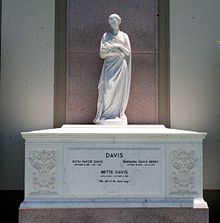
Tomb of Bette Davis
After abandoning Wicked Stepmother and with no further film offers (though she was keen to play the centenarian in Craig Calman’s The Turn Of The Century and worked with him on adapting the stage play to a feature length screenplay), Davis appeared on several talk shows and was interviewed by Johnny Carson, Joan Rivers, Larry King and David Letterman, discussing her career but refusing to discuss her daughter. Her appearances were popular; Lindsay Anderson observed that the public enjoyed seeing her behaving “so bitchy.” He commented, “I always disliked that because she was encouraged to behave badly. And I’d always hear her described by that awful word, feisty.”[84]
During 1988 and 1989, Davis was fêted for her career achievements, receiving the Kennedy Center Honor, the Legion of Honor from France, the Campione d’Italia from Italy and the Film Society of Lincoln Center Lifetime Achievement Award. She collapsed during the American Cinema Awards in 1989 and later discovered that her cancer had returned. She recovered sufficiently to travel to Spain where she was honored at the Donostia-San Sebastián International Film Festival, but during her visit her health rapidly deteriorated. Too weak to make the long journey back to the U.S., she traveled to France where she died on October 6, 1989, at 11:20 pm, at the American Hospital in Neuilly-sur-Seine. Davis was 81 years old. She was interred in Forest Lawn—Hollywood Hills Cemetery in Los Angeles, alongside her mother, Ruthie, and sister, Bobby, with her name in larger type size. On her tombstone is written: “She did it the hard way,” an epitaph that she mentioned in her memoir Mother Goddam as having been suggested to her by Joseph L. Mankiewicz shortly after they had filmed All About Eve.[85]
Reception and legacy
As early as 1936, Graham Greene summed Davis up: “Even the most inconsiderable film … seemed temporarily better than they were because of that precise, nervy voice, the pale ash-blond hair, the popping, neurotic eyes, a kind of corrupt and phosphorescent prettiness …. I would rather watch Miss Davis than any number of competent pictures.”
In 1964, Jack Warner spoke of the “magic quality that transformed this sometimes bland and not beautiful little girl into a great artist,”[85] and in a 1988 interview, Davis remarked that, unlike many of her contemporaries, she had forged a career without the benefit of beauty.[86] She admitted she was terrified during the making of her earliest films and that she became tough by necessity. “Until you’re known in my profession as a monster, you are not a star,” she said, “[but] I’ve never fought for anything in a treacherous way. I’ve never fought for anything but the good of the film.”[87] During the making of All About Eve, (1950) Joseph L. Mankiewicz told her of the perception in Hollywood that she was difficult, and she explained that when the audience saw her on screen, they did not consider that her appearance was the result of numerous people working behind the scenes. If she was presented as “a horse’s ass … forty feet wide, and thirty feet high,” that is all the audience “would see or care about.”[88]
While lauded for her achievements, Davis and her films were sometimes derided; Pauline Kael described Now, Voyager (1942) as a “shlock classic,”[89] and by the mid-1940s her sometimes mannered and histrionic performances had become the subject of caricature. Edwin Schallert for the Los Angeles Times praised Davis’s performance in Mr. Skeffington (1944), while observing, “the mimics will have more fun than a box of monkeys imitating Miss Davis,” and Dorothy Manners at the Los Angeles Examiner said of her performance in the poorly received Beyond the Forest (1949), “no night club caricaturist has ever turned in such a cruel imitation of the Davis mannerisms as Bette turns on herself in this one.” Time magazine noted that Davis was compulsively watchable even while criticizing her acting technique, summarizing her performance in Dead Ringer (1964) with the observation, “her acting, as always, isn’t really acting: it’s shameless showing off. But just try to look away!”[90]
She attracted a following in the gay subculture[91] and was frequently imitated by female impersonators such as Tracey Lee and Charles Pierce.[92] Attempting to explain her popularity with gay audiences, the journalist Jim Emerson wrote, “Was she just a camp figurehead because her brittle, melodramatic style of acting hadn’t aged well? Or was it that she was ‘Larger Than Life,’ a tough broad who had survived? Probably some of both.”[86]
Davis’s film choices were often unconventional; she sought roles as manipulators and killers in an era when actresses usually preferred to play sympathetic characters, and she excelled in them. She favored authenticity over glamour and was willing to change her own appearance if it suited the character. Claudette Colbert commented that Davis was the first actress to play roles older than herself, and therefore did not have to make the difficult transition to character parts as she aged.[87]
As she entered old age, Davis was acknowledged for her achievements. John Springer, who had arranged her speaking tours of the early 1970s, wrote that despite the accomplishments of many of her contemporaries, Davis was “the star of the thirties and into the forties,” achieving notability for the variety of her characterizations and her ability to assert herself, even when her material was mediocre.[93] Individual performances continued to receive praise; in 1987, Bill Collins analyzed The Letter (1940), and described her performance as “a brilliant, subtle achievement,” and wrote, “Bette Davis makes Leslie Crosbie one of the most extraordinary females in movies.”[94] In a 2000 review for All About Eve, (1950) Roger Ebert noted, “Davis was a character, an icon with a grand style, so even her excesses are realistic.”[95] In 2006, Premiere magazine ranked her portrayal of Margo Channing in the film as fifth on their list of “100 Greatest Performances of All Time,” commenting, “There is something deliciously audacious about her gleeful willingness to play such unattractive emotions as jealousy, bitterness, and neediness.”[96] While reviewing What Ever Happened to Baby Jane? (1962) in 2008, Ebert asserted that “no one who has seen the film will ever forget her.”[97]
A few months before her death in 1989, Davis was one of several actors featured on the cover of Life magazine. In a film retrospective that celebrated the films and stars of 1939, Life concluded that Davis was the most significant actress of her era, and highlighted Dark Victory (1939) as one of the most-important films of the year.[98] Her death made front-page news throughout the world as the “close of yet another chapter of the Golden Age of Hollywood.” Angela Lansbury summed up the feeling of those of the Hollywood community who attended her memorial service, commenting after a sample from Davis’s films were screened, that they had witnessed “an extraordinary legacy of acting in the twentieth century by a real master of the craft,” that should provide “encouragement and illustration to future generations of aspiring actors.”[99]
In 1977, Davis became the first woman to be honored with the AFI Life Achievement Award.[100] In 1999, the American Film Institute published its list of the “AFI’s 100 Years… 100 Stars,” which was the result of a film-industry poll to determine the “50 Greatest American Screen Legends” in order to raise public awareness and appreciation of classic film. Of the 25 actresses listed, Davis was ranked at number two, behind Katharine Hepburn.[101]
The United States Postal Service honored Davis with a commemorative postage stamp in 2008, marking the 100th anniversary of her birth.[102] The stamp features an image of her in the role of Margo Channing in All About Eve (1950). The First Day of Issue celebration took place September 18, 2008, at Boston University, which houses an extensive Bette Davis archive. Featured speakers included her son Michael Merrill and Lauren Bacall.
In 1997, the executors of her estate, Michael Merrill, her son, and Kathryn Sermak, her former assistant, established “The Bette Davis Foundation” which awards college scholarships to promising actors and actresses.[40]
Davis told Johnny Carson in a 1983 interview on The Tonight Show that as an actress, she wanted to be remembered as being a “good worker.”
Academy Awards milestones

Davis in the trailer for
Dark Victory (1939), in which she gave one of her ten Oscar-nominated performances
In 1962 Bette Davis became the first person to secure ten Academy Award nominations for acting. Since then only four people have equalled or surpassed this figure, Meryl Streep (with eighteen nominations and three wins), Katharine Hepburn (twelve nominations and four wins), Jack Nicholson (twelve nominations and three wins) and Laurence Olivier (ten nominations and one win).[103]
Steven Spielberg purchased Davis’s Oscars for Dangerous (1935) and Jezebel (1938) when they were offered for auction for $207,500 and $578,000, respectively, and returned them to the Academy of Motion Picture Arts and Sciences.[104][105]
- 1934: Davis’s performance in Of Human Bondage (1934) was widely acclaimed and when she was not nominated for an Academy Award, several influential people mounted a campaign to have her name included. The Academy relaxed its rules for that year only to allow for the consideration of any performer nominated in a write-in vote; therefore, any performance of the year was technically eligible for consideration. Given the well-publicized hoopla, some sources still consider this as a nomination for Davis; however, the Academy does not officially record this as a nomination.[19]
- 1935: Won for Dangerous
- 1938: Won for Jezebel
- 1939: Nominated for Dark Victory
- 1940: Nominated for The Letter
- 1941: Nominated for The Little Foxes
- 1942: Nominated for Now, Voyager
- 1944: Nominated for Mr. Skeffington
- 1950: Nominated for All About Eve
- 1952: Nominated for The Star
- 1962: Nominated for What Ever Happened to Baby Jane?
Selected filmography



